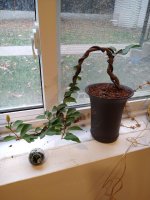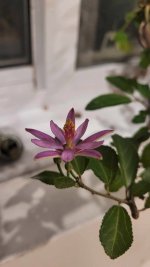ColdButComfyWinterBreeze
Seedling
Hello bonsai nuts,
I am very new to bonsai, I don't know how to properly take care of one yet and you will probably notice that reading through this post. I was given this bonsai tree sometime around November of 2024. It was in great health, as you can see by the first picture. The guy who gave it to me told me to water it often and keep it indoors. So for most of the time I've had it, I've kept it indoors(Yes, I know now I shouldn't have done that) and watered it regularly, at least 5 to 6 times a week. For a while it looked healthy and grew flowers, but I have since moved to a new place.

My mother, while visiting, accidentally knocked it over and shattered the pot on the ground. I very quickly found a new pot at the store and reused it's substrate, but couldn't gather enough of the brown substrate to cover the top. I couldn't find the same substrate anywhere, so had to go with sphagnum moss instead. If you could tell me what substrate that is in the first picture, that'd be very helpful. I shredded a very small amount of the sphagnum moss and mixed it into the substrate as well as putting a thin layer on top as recommended by some other sources.

It now looks like this. It hurts me so much to see it in this state and I haven't treated this tree with the respect it deserves. I still water it regularly, I keep it outdoors now, but it snows in December through February, so I have to keep it indoors for a few months. It has some new leaves growing and 2 somewhat healthy branches with green leaves, but hasn't bloomed new flowers since last year. Any and all advice will be greatly appreciated and applied to the best of my ability. If you can tell me what specie of tree it is, that'd be great. I tried using google lens by taking pictures of the leaves, but wasn't satisfied with the answers. I'm looking forward to making this plant look beautiful like it was last year.
Thank you
I am very new to bonsai, I don't know how to properly take care of one yet and you will probably notice that reading through this post. I was given this bonsai tree sometime around November of 2024. It was in great health, as you can see by the first picture. The guy who gave it to me told me to water it often and keep it indoors. So for most of the time I've had it, I've kept it indoors(Yes, I know now I shouldn't have done that) and watered it regularly, at least 5 to 6 times a week. For a while it looked healthy and grew flowers, but I have since moved to a new place.

My mother, while visiting, accidentally knocked it over and shattered the pot on the ground. I very quickly found a new pot at the store and reused it's substrate, but couldn't gather enough of the brown substrate to cover the top. I couldn't find the same substrate anywhere, so had to go with sphagnum moss instead. If you could tell me what substrate that is in the first picture, that'd be very helpful. I shredded a very small amount of the sphagnum moss and mixed it into the substrate as well as putting a thin layer on top as recommended by some other sources.

It now looks like this. It hurts me so much to see it in this state and I haven't treated this tree with the respect it deserves. I still water it regularly, I keep it outdoors now, but it snows in December through February, so I have to keep it indoors for a few months. It has some new leaves growing and 2 somewhat healthy branches with green leaves, but hasn't bloomed new flowers since last year. Any and all advice will be greatly appreciated and applied to the best of my ability. If you can tell me what specie of tree it is, that'd be great. I tried using google lens by taking pictures of the leaves, but wasn't satisfied with the answers. I'm looking forward to making this plant look beautiful like it was last year.
Thank you


